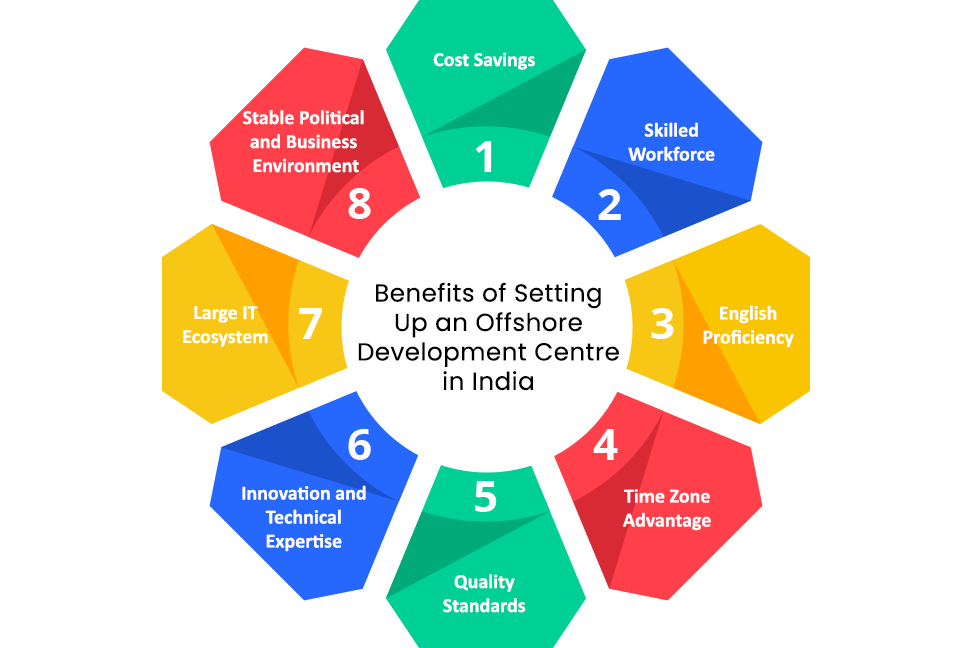In today’s globalized world, offshore development centre’s (ODCs) have become a popular choice for businesses looking to leverage cost advantages and tap into a diverse talent pool. India, with its thriving IT industry and skilled workforce, has emerged as a top destination for setting up offshore development centres. This article aims to provide a comprehensive guide on how to establish an offshore development centre in India, highlighting the benefits, challenges, and key considerations along the way.
But first let’s understand what an Offshore Development Centre is?:
An offshore development centre (ODC) is a dedicated facility or team located in a foreign country that provides software development, IT support, or other technology-related services for a company located elsewhere. ODCs have gained immense popularity in the global business landscape as organizations seek to leverage cost advantages and tap into a diverse talent pool. These centre’s offer several advantages, including cost savings, access to skilled professionals, and the ability to focus on core business functions. By establishing an ODC, companies can benefit from the expertise and resources of a dedicated team located in a different geographical location, allowing for greater flexibility, scalability, and efficiency in software development and technology services. The concept of ODCs enables businesses to expand their capabilities, accelerate product development, and gain a competitive edge in the market.
Benefits of Setting Up an Offshore Development Centre in India

India has gained prominence as a preferred destination for offshore development centre’s due to many reasons. Here are some of the benefits of setting up an offshore development centre in India, supported by relevant data points:
1. Cost Savings: India offers significant cost advantages, making it an attractive destination for offshore development centre’s.
According to a survey by Deloitte, offshoring to India can result in cost savings of up to 60% compared to in-house development or outsourcing to other countries.
2. Skilled Workforce: India has a large pool of skilled IT professionals with expertise in various technologies.
India produces a substantial number of engineering and IT graduates each year. As of 2020, India had over 4.5 million IT professionals, as reported by the National Association of Software and Service Companies (NASSCOM).
3. English Proficiency: English is widely spoken and understood in India, facilitating smooth communication with clients and stakeholders.
India ranks second globally in terms of English-speaking population, with over 125 million English speakers, as per a report by the English Proficiency Index.
4. Time Zone Advantage: India’s time zone allows for better collaboration with businesses in North America and Europe.
India is approximately 9-12 hours ahead of the United States, enabling round-the-clock productivity and real-time collaboration between onshore and offshore teams.
5. Quality Standards: Indian offshore development centres adhere to international quality standards and best practices.
Many Indian IT companies are certified in various quality management systems, such as ISO 9001, CMMI (Capability Maturity Model Integration), and Six Sigma, ensuring a focus on quality and process improvement.
6. Innovation and Technical Expertise: Indian professionals are known for their innovative thinking and technical prowess.
India has a thriving start-up ecosystem and has consistently ranked among the top countries in terms of technology innovation, as indicated by global innovation indexes such as the Global Innovation Index and the Bloomberg Innovation Index.
7. Large IT Ecosystem: India has a well-established IT ecosystem, comprising companies, research institutions, and tech communities, fostering collaboration and knowledge sharing.
India is home to numerous technology parks, IT clusters, and research institutes, such as the Software Technology Parks of India (STPI), Indian Institutes of Technology (IITs), and Indian Institutes of Information Technology (IIITs).
8. Stable Political and Business Environment: India offers a stable political and business environment, providing a conducive atmosphere for offshore operations.
The World Bank’s Ease of Doing Business Index 2020 ranked India at 63 out of 190 countries, reflecting improvements in regulatory reforms and ease of doing business.
By leveraging these benefits, businesses can establish offshore development centre’s in India, tapping into its skilled workforce, cost advantages, and technological expertise to drive growth and innovation.
Also Read: Why Build an ODC in India?
Let’s get to know the Key Steps to Setting Up an Offshore Development Centre in India:
1. Define Your Goals and Requirements: Clearly define your objectives, project requirements, and the roles and responsibilities of the offshore team. Identify the specific skill sets needed and the scope of work to be performed at the ODC.
According to the National Association of Software and Service Companies (NASSCOM), India has a vast talent pool of over 4.5 million IT professionals, making it easier to find the required expertise for your offshore development centre.
2. Choose the Right Location: Select a suitable location for your offshore development centre. Major IT hubs in India include Bengaluru, Hyderabad, Chennai, Pune, and Gurugram, among others. Consider factors such as infrastructure, availability of talent, cost of living, and local regulations.
Bengaluru, often referred to as the “Silicon Valley of India,” is one of the most popular choices for setting up offshore development centre’s. It has a robust infrastructure, a thriving tech ecosystem, and a large talent pool.
3. Legal and Compliance Considerations: Familiarize yourself with the legal and compliance requirements of establishing a business entity in India. This includes company registration, tax obligations, intellectual property protection, and data privacy laws. India has made significant strides in intellectual property protection.
According to the Global Intellectual Property Centre’s International IP Index 2021, India improved its score by over 10% compared to the previous year, indicating a positive environment for protecting intellectual property rights.
4. Establish a Legal Entity: Determine the most appropriate legal structure for your offshore development centre, such as a wholly owned subsidiary, joint venture, or partnership. Seek legal advice to ensure compliance with Indian laws and regulations.
India has a well-defined legal framework for establishing business entities. The World Bank’s Ease of Doing Business Index 2020 ranked India at 63 out of 190 countries, reflecting improvements in the ease of starting a business.
5. Infrastructure and Technology: Set up a robust IT infrastructure to support your offshore operations. This includes reliable internet connectivity, secure data storage, collaboration tools, and communication systems.
India has made significant advancements in its digital infrastructure. As of January 2021, India has the second-largest internet user base in the world, with over 624 million internet users, ensuring access to reliable connectivity.
6. Recruit and Onboard Talent: Identify the required skill sets and begin the recruitment process. Leverage local job portals, professional networks, and recruitment agencies to attract qualified professionals. Develop an effective onboarding program to integrate the offshore team with your existing organization seamlessly.
India produces a large number of engineering and IT graduates each year. In 2019-2020, around 1.5 million engineering graduates and 2.3 million IT professionals were added to the talent pool, offering a wide range of skilled resources for your offshore development centre.
7. Establish Communication Channels: Effective communication is crucial for successful collaboration. Set up communication channels such as video conferencing, project management tools, and chat platforms to facilitate seamless interaction between onshore and offshore teams.
With the rapid growth of the IT industry, India has developed a robust communication infrastructure. It is estimated that India has more than 1 billion mobile phone subscribers, ensuring reliable and accessible communication channels.
Security and Intellectual Property Protection: Implement robust security measures to safeguard intellectual property and sensitive information. This includes strict access controls, data encryption, non-disclosure agreements, and regular security audits.
India has enacted several laws to protect intellectual property rights, including the Copyright Act, the Patents Act, and the Trademarks Act. These laws provide legal recourse and protection for intellectual property assets.
Project Management and Governance: Establish clear project management processes, define roles and responsibilities, and implement governance frameworks to ensure transparency, accountability, and effective project delivery. India has a strong project management talent base. The Project Management Institute’s (PMI) Pulse of the Profession® report in 2020 ranked India among the top 10 countries with the highest project management maturity levels.
By following these key steps, businesses can set up a successful offshore development centre in India, leveraging the country’s abundant talent pool, favourable business environment, and robust IT infrastructure.
Setting up an offshore development centre in India offers numerous benefits, including cost savings, access to skilled professionals, and a favourable business environment. By following the key steps outlined in this article, businesses can establish a successful offshore presence in India, tapping into the country’s vast talent pool and reaping the rewards of global collaboration. However, it is crucial to remain vigilant and stay informed about evolving legal, regulatory, and market conditions to navigate the challenges associated with offshore operations effectively.


